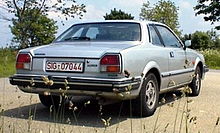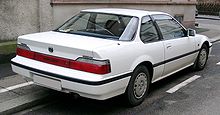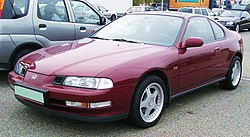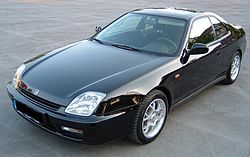Honda Prelude
| Honda Prelude | |
|---|---|
| Production period: | 1978-2002 |
| Class : | Sports car |
| Body versions : | Coupe |
The Honda Prelude is a mid -range sports coupé from the Japanese car manufacturer Honda . The name Prelude means something like prelude, prelude or introduction in German and goes back to the fact that this model became Honda's technology test vehicle during the course of construction, in which numerous innovations went into series for the first time. In Germany it was only available until the end of 2000; for the American market it continued to be built until 2002. There were five generations.
First generation
In 1978 the first generation of the Honda Prelude was presented as a sports coupé based on the Accord (type code SN). It was thus the third Honda series alongside the Civic and the Accord. The company Tropic from Crailsheim produced a total of 47 convertibles from this model between 1981 and 1983.
In the Prelude, the Accord's CVCC engines with 1.8 liter displacement for the Japanese and North American markets and 1.6 liter displacement for the other export markets were used. The smaller engine developed 59 kW (80 hp). An electrically operated sliding glass roof was offered as the first vehicle in its class. From model year 1980 it was available with a three -speed automatic called Hondamatic .
Model overview
| Construction year | model | Displacement | power | countries |
|---|---|---|---|---|
| 1978-1983 | 1.6 | 1602 cc | 59 kW (80 PS) | Australia , Europe , Canada |
| 1978-1983 | 1.8 | 1750 cc | 66 kW (90 PS) | Japan, USA |
Second generation
With the appearance of the second generation of the Prelude (type code AB) in 1982, the technological pioneering role of the model series began: The new 1.8-liter engine was Honda's first three-valve engine with double carburetors . Compared to its predecessor, this generation grew in size and got more powerful engines. In addition to the 1.8-liter engine, a 2.0-liter DOHC engine with manifold injection came onto the market in 1985. The 1.8 liter three-valve engine, which was available until the generation change in 1987, was more powerful in the Prelude than the CVCC engine of its predecessor, but due to the increased weight and the larger body, this increase in performance was hardly noticeable. The rest was done from 1985 onwards by installing a catalytic converter . All engines were combined with a manual five-speed gearbox as standard. A four-stage automatic was also available. In Japan, a 16-valve DOHC engine with manifold injection was also available, which was also available in Europe from 1985 until the model change in 1987 (type code BA2). The installation of the taller engine required some changes to the front end, which Honda implemented through a facelift. Most noticeable were the modified radiator grille, the now arched bonnet, the modified bumpers, the rear spoiler painted in body color and larger wheels and tires. The easy-revving intake manifold injection was combined as standard with an appropriately designed five-speed manual gearbox. Alternatively, this Prelude could also be delivered with a revised four-speed automatic. The last models of the 16V were offered with a regulated catalytic converter at the end of 1986. The car also lived up to its technological pioneering role because it was the first Japanese car with a standard anti-lock braking system . Another innovation in the Japanese version was Honda's first navigation system. In addition, with this Prelude, the double wishbone suspension with double wishbones on the front axle was introduced into series production.
Model overview
| Construction year | model | Displacement | power | countries |
|---|---|---|---|---|
| 1982-1987 | EX 1.8 | 1829 cc | 77 kW (105 PS) | Europe |
| 1985-1987 | EX 2.0 | 1958 cc | 80 kW (109 PS) | Europe |
| 1985-1987 | EX 2.0i-16 | 1958 cc | 101 kW (137 hp) | Europe |
| 1982-1987 | 1.8 | 1829 cc | 92 kW (125 PS) | Japan |
| 1985-1987 | 2.0 16V | 1958 cc | 118 kW (160 PS) | Japan |
| 1982-1987 | 2.0 | 1955 cc | 81 kW (110 PS) | Australia, USA |
| 1987 | 1.8 | 1829 cc | 74 kW (100 PS) | United States |
| 1982-1986 | 2.0 | 1955 cc | 81 kW (110 PS) | United States |
Third generation
In 1987 the third generation of the Prelude (type code BA4) appeared in Japan. This became the most successful of the Prelude generations.
This Prelude was motorized with a 2.0-liter unit, which was offered in different performance levels. In the last model year there was a slightly drilled DOHC engine for the "Si4" in North America and Japan. These engines were combined with either a manual five-speed gearbox or the four-speed automatic.
The technical innovation of this Prelude was the first steering angle-dependent mechanical four-wheel steering available in a series vehicle . This technology resulted in improved cornering and a turning circle reduced by around one meter. At Honda this system is called 4WS (Four- W heel S teering).
In 1989 the Prelude got a facelift with white indicators at the front and rear as well as revised fittings. The output of the top model has been increased from 101 kW (137 hp) to 103 kW (140 hp). A model called Prelude “INX” and the “Si” with the so-called TCV (integrated TCS with 4WS , ABS and a limited-slip differential ) also appeared on the Japanese market . In Australia, the Prelude was voted "Car of the Year 1987" by Wheels Magazine .
Model overview
| Construction year | model | Displacement | power | countries | annotation |
|---|---|---|---|---|---|
| 1987-1992 | 2.0EX | 1944 cc | 80 kW (109 PS) | Germany | with cat |
| 1987-1992 | 2.0EX | 1944 cc | 84 kW (114 hp) | Germany | without cat |
| 1987-1989 | 2.0i-16V | 1958 cc | 101 kW (137 hp) | Germany | with cat |
| 1989-1992 | 2.0i-16V | 1958 cc | 103 kW (140 PS) | Germany | with cat |
| 1990-1991 | Si (US version) | 2056 cc | 110 kW (149 hp) | United States | with cat |
Fourth generation
| Prelude IV | |
|---|---|
|
Honda Prelude (1992-1996) |
|
| Production period: | 1992-1996 |
| Body versions : | Coupe |
| Engines: |
Petrol engines : 2.0–2.3 liters (98–147 kW) |
| Length: | 4440 mm |
| Width: | 1765 mm |
| Height: | 1290 mm |
| Wheelbase : | 2550 mm |
| Empty weight : | 1210-1340 kg |
The fourth generation of the Prelude sports coupe appeared in Japan in 1992 (type code BB1 / 2/3) with a completely redesigned body. The export did not start until the following year. In Japan, the Prelude was offered with two 2.2-liter DOHC engines - one of them with VTEC technology. This unit was only used in export from 1993. The other engine was not exported to Europe. Here there was the Prelude with the 2.0-liter SOHC engine from the Accord as an entry-level model . Otherwise, a new 2.3-liter DOHC engine was used for export. These engines were combined either with a manual 5-speed gearbox or the 4-speed automatic. In this model, four-wheel steering 4WS was supplemented by an electronic control.
Model overview
| Construction year | model | Model code | Displacement | power | countries |
|---|---|---|---|---|---|
| 1992-1996 | 2.0i | BB3 | 1997 cc | 98 kW (133 hp) | Europe |
| 1992-1996 | 2.2i | BB4 | 2157 cc | 147 kW (200 hp) | Japan |
| 1992-1996 | 2.3i | BB2 | 2259 cc | 118 kW (160 PS) | Australia, Europe, USA |
| 1992-1996 | 2.2 VTEC | BB1 | 2157 cc | 136 kW (185 hp) | Europe |
| BB1 | 147 kW (200 hp) | Japan | |||
| 1992-1996 | 2.2 VTEC | BA8 | 2156 cc | 99 kW (135 hp) | Australia, USA |
| BA8 | 118 kW (160 PS) | Japan | |||
| 1992-1996 | 2.3 | 2256 cc | 118 kW (160 PS) | Japan |
Fifth generation
| Prelude V (BB) | |
|---|---|
|
Honda Prelude (1997-2002) |
|
| Production period: | 1997-2002 |
| Body versions : | Coupe |
| Engines: |
Petrol engines : 2.0–2.2 liters (98–147 kW) |
| Length: | 4545 mm |
| Width: | 1750 mm |
| Height: | 1315 mm |
| Wheelbase : | 2585 mm |
| Empty weight : | 1190-1385 kg |
The fifth generation of the Prelude appeared in 1997 (type code BB6 / 8/9) again with a completely changed body. The design was based on the 3rd generation models, as the 4th generation did not meet sales expectations.
The last Prelude generation was built from January 1997 to mid-2002 (type code BB6 / 8/9). However, it had not been available in Germany since the end of 2000. In 2002 production was completely stopped. In mid-2002 only the 200 hp 2.2VTi was still available on the American market.
The engine selection, however, remained essentially the same. The basic model in Japan had a 2.2 liter SOHC machine. The DOHC variant of this unit was exported to Australia and New Zealand , for example . The world's top engine was the 2.2-liter DOHC engine of the H22 series with VTEC technology, which was taken over from its predecessor . In North America it was the only engine variant offered. In Europe, the base engine was the 2.0-liter SOHC engine (F20A4) from the Accord. In Japan, there also was a Type-S variant with modified suspension and a performance 2.2-liter engine with 164 kW (220 hp) at 7,200 min -1 and 220 Nm at 6500 min -1 . These engines were combined either with a manual 5-speed gearbox or the four-speed automatic.
Upon request, the top model could be equipped with the electronically controlled, electrically operated 4WS four-wheel steering system known from its predecessor . The technical innovation of this Prelude, however, was an electronically controlled, active drive force distribution ( ATTS - A ctive T orque T ransfer S ystem), which reduces the tendency to understeer when cornering by driving the outside wheel faster and more strongly. This resulted in a significantly improved cornering behavior. Thanks to this system, it was voted “best-handling car under $ 30,000” in the American Car and Driver Magazine 1997 .
Model overview
| model | Displacement | camshaft | power | annotation | Construction year |
|---|---|---|---|---|---|
| 2.0i | 1997 cc | SOHC | 98 kW (133 hp) | 1996-2000 | |
| 2.2VTi | 2157 cc | DOHC VTEC | 136 kW (185 hp) | also with all-wheel steering | 1997-2000 |
| 2.2VTi | 2157 cc | DOHC VTEC | 147 kW (200 hp) | also with all-wheel steering | 2000-2002 |
| 2.2 Type-S | 2157 cc | DOHC VTEC | 164 kW (220 hp) | only in Japan | 1997-2002 |









